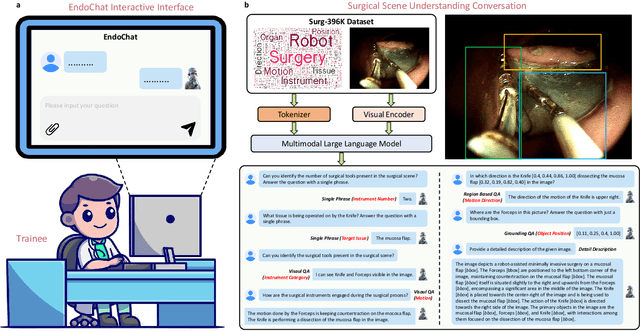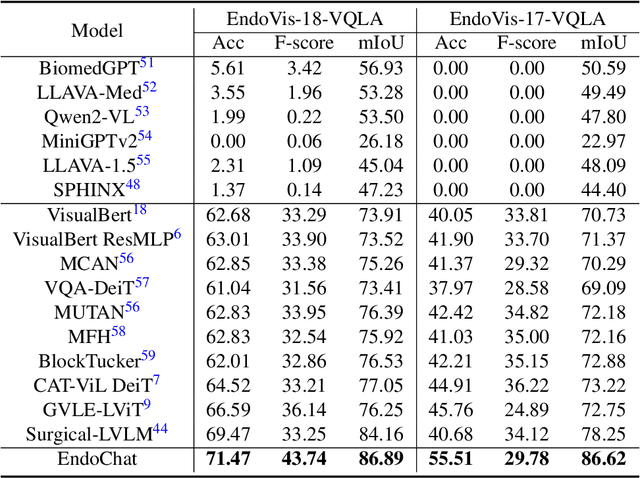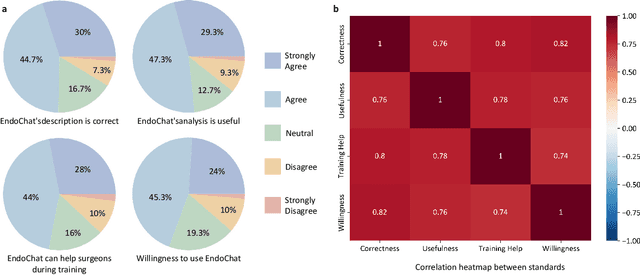Jinlin Wu
Multimodal Causal-Driven Representation Learning for Generalizable Medical Image Segmentation
Aug 07, 2025Abstract:Vision-Language Models (VLMs), such as CLIP, have demonstrated remarkable zero-shot capabilities in various computer vision tasks. However, their application to medical imaging remains challenging due to the high variability and complexity of medical data. Specifically, medical images often exhibit significant domain shifts caused by various confounders, including equipment differences, procedure artifacts, and imaging modes, which can lead to poor generalization when models are applied to unseen domains. To address this limitation, we propose Multimodal Causal-Driven Representation Learning (MCDRL), a novel framework that integrates causal inference with the VLM to tackle domain generalization in medical image segmentation. MCDRL is implemented in two steps: first, it leverages CLIP's cross-modal capabilities to identify candidate lesion regions and construct a confounder dictionary through text prompts, specifically designed to represent domain-specific variations; second, it trains a causal intervention network that utilizes this dictionary to identify and eliminate the influence of these domain-specific variations while preserving the anatomical structural information critical for segmentation tasks. Extensive experiments demonstrate that MCDRL consistently outperforms competing methods, yielding superior segmentation accuracy and exhibiting robust generalizability.
SurgVisAgent: Multimodal Agentic Model for Versatile Surgical Visual Enhancement
Jul 03, 2025



Abstract:Precise surgical interventions are vital to patient safety, and advanced enhancement algorithms have been developed to assist surgeons in decision-making. Despite significant progress, these algorithms are typically designed for single tasks in specific scenarios, limiting their effectiveness in complex real-world situations. To address this limitation, we propose SurgVisAgent, an end-to-end intelligent surgical vision agent built on multimodal large language models (MLLMs). SurgVisAgent dynamically identifies distortion categories and severity levels in endoscopic images, enabling it to perform a variety of enhancement tasks such as low-light enhancement, overexposure correction, motion blur elimination, and smoke removal. Specifically, to achieve superior surgical scenario understanding, we design a prior model that provides domain-specific knowledge. Additionally, through in-context few-shot learning and chain-of-thought (CoT) reasoning, SurgVisAgent delivers customized image enhancements tailored to a wide range of distortion types and severity levels, thereby addressing the diverse requirements of surgeons. Furthermore, we construct a comprehensive benchmark simulating real-world surgical distortions, on which extensive experiments demonstrate that SurgVisAgent surpasses traditional single-task models, highlighting its potential as a unified solution for surgical assistance.
SA-Person: Text-Based Person Retrieval with Scene-aware Re-ranking
May 30, 2025Abstract:Text-based person retrieval aims to identify a target individual from a gallery of images based on a natural language description. It presents a significant challenge due to the complexity of real-world scenes and the ambiguity of appearance-related descriptions. Existing methods primarily emphasize appearance-based cross-modal retrieval, often neglecting the contextual information embedded within the scene, which can offer valuable complementary insights for retrieval. To address this, we introduce SCENEPERSON-13W, a large-scale dataset featuring over 100,000 scenes with rich annotations covering both pedestrian appearance and environmental cues. Based on this, we propose SA-Person, a two-stage retrieval framework. In the first stage, it performs discriminative appearance grounding by aligning textual cues with pedestrian-specific regions. In the second stage, it introduces SceneRanker, a training-free, scene-aware re-ranking method leveraging multimodal large language models to jointly reason over pedestrian appearance and the global scene context. Experiments on SCENEPERSON-13W validate the effectiveness of our framework in challenging scene-level retrieval scenarios. The code and dataset will be made publicly available.
From Data to Modeling: Fully Open-vocabulary Scene Graph Generation
May 26, 2025Abstract:We present OvSGTR, a novel transformer-based framework for fully open-vocabulary scene graph generation that overcomes the limitations of traditional closed-set models. Conventional methods restrict both object and relationship recognition to a fixed vocabulary, hindering their applicability to real-world scenarios where novel concepts frequently emerge. In contrast, our approach jointly predicts objects (nodes) and their inter-relationships (edges) beyond predefined categories. OvSGTR leverages a DETR-like architecture featuring a frozen image backbone and text encoder to extract high-quality visual and semantic features, which are then fused via a transformer decoder for end-to-end scene graph prediction. To enrich the model's understanding of complex visual relations, we propose a relation-aware pre-training strategy that synthesizes scene graph annotations in a weakly supervised manner. Specifically, we investigate three pipelines--scene parser-based, LLM-based, and multimodal LLM-based--to generate transferable supervision signals with minimal manual annotation. Furthermore, we address the common issue of catastrophic forgetting in open-vocabulary settings by incorporating a visual-concept retention mechanism coupled with a knowledge distillation strategy, ensuring that the model retains rich semantic cues during fine-tuning. Extensive experiments on the VG150 benchmark demonstrate that OvSGTR achieves state-of-the-art performance across multiple settings, including closed-set, open-vocabulary object detection-based, relation-based, and fully open-vocabulary scenarios. Our results highlight the promise of large-scale relation-aware pre-training and transformer architectures for advancing scene graph generation towards more generalized and reliable visual understanding.
Compile Scene Graphs with Reinforcement Learning
Apr 18, 2025Abstract:Next token prediction is the fundamental principle for training large language models (LLMs), and reinforcement learning (RL) further enhances their reasoning performance. As an effective way to model language, image, video, and other modalities, the use of LLMs for end-to-end extraction of structured visual representations, such as scene graphs, remains underexplored. It requires the model to accurately produce a set of objects and relationship triplets, rather than generating text token by token. To achieve this, we introduce R1-SGG, a multimodal LLM (M-LLM) initially trained via supervised fine-tuning (SFT) on the scene graph dataset and subsequently refined using reinforcement learning to enhance its ability to generate scene graphs in an end-to-end manner. The SFT follows a conventional prompt-response paradigm, while RL requires the design of effective reward signals. Given the structured nature of scene graphs, we design a graph-centric reward function that integrates node-level rewards, edge-level rewards, and a format consistency reward. Our experiments demonstrate that rule-based RL substantially enhances model performance in the SGG task, achieving a zero failure rate--unlike supervised fine-tuning (SFT), which struggles to generalize effectively. Our code is available at https://github.com/gpt4vision/R1-SGG.
Iterative Prompt Relocation for Distribution-Adaptive Visual Prompt Tuning
Mar 10, 2025Abstract:Visual prompt tuning (VPT) provides an efficient and effective solution for adapting pre-trained models to various downstream tasks by incorporating learnable prompts. However, most prior art indiscriminately applies a fixed prompt distribution across different tasks, neglecting the importance of each block differing depending on the task. In this paper, we investigate adaptive distribution optimization (ADO) by addressing two key questions: (1) How to appropriately and formally define ADO, and (2) How to design an adaptive distribution strategy guided by this definition? Through in-depth analysis, we provide an affirmative answer that properly adjusting the distribution significantly improves VPT performance, and further uncover a key insight that a nested relationship exists between ADO and VPT. Based on these findings, we propose a new VPT framework, termed PRO-VPT (iterative Prompt RelOcation-based VPT), which adaptively adjusts the distribution building upon a nested optimization formulation. Specifically, we develop a prompt relocation strategy for ADO derived from this formulation, comprising two optimization steps: identifying and pruning idle prompts, followed by determining the optimal blocks for their relocation. By iteratively performing prompt relocation and VPT, our proposal adaptively learns the optimal prompt distribution, thereby unlocking the full potential of VPT. Extensive experiments demonstrate that our proposal significantly outperforms state-of-the-art VPT methods, e.g., PRO-VPT surpasses VPT by 1.6% average accuracy, leading prompt-based methods to state-of-the-art performance on the VTAB-1k benchmark. The code is available at https://github.com/ckshang/PRO-VPT.
Advancing Dense Endoscopic Reconstruction with Gaussian Splatting-driven Surface Normal-aware Tracking and Mapping
Jan 31, 2025



Abstract:Simultaneous Localization and Mapping (SLAM) is essential for precise surgical interventions and robotic tasks in minimally invasive procedures. While recent advancements in 3D Gaussian Splatting (3DGS) have improved SLAM with high-quality novel view synthesis and fast rendering, these systems struggle with accurate depth and surface reconstruction due to multi-view inconsistencies. Simply incorporating SLAM and 3DGS leads to mismatches between the reconstructed frames. In this work, we present Endo-2DTAM, a real-time endoscopic SLAM system with 2D Gaussian Splatting (2DGS) to address these challenges. Endo-2DTAM incorporates a surface normal-aware pipeline, which consists of tracking, mapping, and bundle adjustment modules for geometrically accurate reconstruction. Our robust tracking module combines point-to-point and point-to-plane distance metrics, while the mapping module utilizes normal consistency and depth distortion to enhance surface reconstruction quality. We also introduce a pose-consistent strategy for efficient and geometrically coherent keyframe sampling. Extensive experiments on public endoscopic datasets demonstrate that Endo-2DTAM achieves an RMSE of $1.87\pm 0.63$ mm for depth reconstruction of surgical scenes while maintaining computationally efficient tracking, high-quality visual appearance, and real-time rendering. Our code will be released at github.com/lastbasket/Endo-2DTAM.
EndoChat: Grounded Multimodal Large Language Model for Endoscopic Surgery
Jan 20, 2025



Abstract:Recently, Multimodal Large Language Models (MLLMs) have demonstrated their immense potential in computer-aided diagnosis and decision-making. In the context of robotic-assisted surgery, MLLMs can serve as effective tools for surgical training and guidance. However, there is still a lack of MLLMs specialized for surgical scene understanding in clinical applications. In this work, we introduce EndoChat to address various dialogue paradigms and subtasks in surgical scene understanding that surgeons encounter. To train our EndoChat, we construct the Surg-396K dataset through a novel pipeline that systematically extracts surgical information and generates structured annotations based on collected large-scale endoscopic surgery datasets. Furthermore, we introduce a multi-scale visual token interaction mechanism and a visual contrast-based reasoning mechanism to enhance the model's representation learning and reasoning capabilities. Our model achieves state-of-the-art performance across five dialogue paradigms and eight surgical scene understanding tasks. Additionally, we conduct evaluations with professional surgeons, most of whom provide positive feedback on collaborating with EndoChat. Overall, these results demonstrate that our EndoChat has great potential to significantly advance training and automation in robotic-assisted surgery.
Universal Domain Adaptive Object Detection via Dual Probabilistic Alignment
Dec 16, 2024Abstract:Domain Adaptive Object Detection (DAOD) transfers knowledge from a labeled source domain to an unannotated target domain under closed-set assumption. Universal DAOD (UniDAOD) extends DAOD to handle open-set, partial-set, and closed-set domain adaptation. In this paper, we first unveil two issues: domain-private category alignment is crucial for global-level features, and the domain probability heterogeneity of features across different levels. To address these issues, we propose a novel Dual Probabilistic Alignment (DPA) framework to model domain probability as Gaussian distribution, enabling the heterogeneity domain distribution sampling and measurement. The DPA consists of three tailored modules: the Global-level Domain Private Alignment (GDPA), the Instance-level Domain Shared Alignment (IDSA), and the Private Class Constraint (PCC). GDPA utilizes the global-level sampling to mine domain-private category samples and calculate alignment weight through a cumulative distribution function to address the global-level private category alignment. IDSA utilizes instance-level sampling to mine domain-shared category samples and calculates alignment weight through Gaussian distribution to conduct the domain-shared category domain alignment to address the feature heterogeneity. The PCC aggregates domain-private category centroids between feature and probability spaces to mitigate negative transfer. Extensive experiments demonstrate that our DPA outperforms state-of-the-art UniDAOD and DAOD methods across various datasets and scenarios, including open, partial, and closed sets. Codes are available at \url{https://github.com/zyfone/DPA}.
SurgBox: Agent-Driven Operating Room Sandbox with Surgery Copilot
Dec 06, 2024Abstract:Surgical interventions, particularly in neurology, represent complex and high-stakes scenarios that impose substantial cognitive burdens on surgical teams. Although deliberate education and practice can enhance cognitive capabilities, surgical training opportunities remain limited due to patient safety concerns. To address these cognitive challenges in surgical training and operation, we propose SurgBox, an agent-driven sandbox framework to systematically enhance the cognitive capabilities of surgeons in immersive surgical simulations. Specifically, our SurgBox leverages large language models (LLMs) with tailored Retrieval-Augmented Generation (RAG) to authentically replicate various surgical roles, enabling realistic training environments for deliberate practice. In particular, we devise Surgery Copilot, an AI-driven assistant to actively coordinate the surgical information stream and support clinical decision-making, thereby diminishing the cognitive workload of surgical teams during surgery. By incorporating a novel Long-Short Memory mechanism, our Surgery Copilot can effectively balance immediate procedural assistance with comprehensive surgical knowledge. Extensive experiments using real neurosurgical procedure records validate our SurgBox framework in both enhancing surgical cognitive capabilities and supporting clinical decision-making. By providing an integrated solution for training and operational support to address cognitive challenges, our SurgBox framework advances surgical education and practice, potentially transforming surgical outcomes and healthcare quality. The code is available at https://github.com/franciszchen/SurgBox.
 Add to Chrome
Add to Chrome Add to Firefox
Add to Firefox Add to Edge
Add to Edge